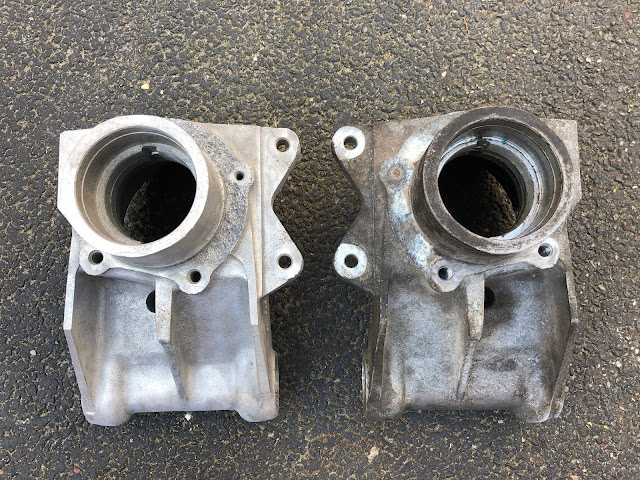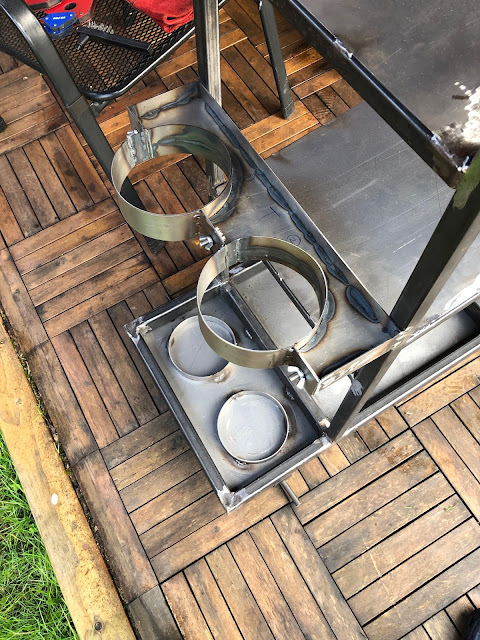Now petrol has a specific gravity of 0.720 (compared to 1.0 for water) and the AK fuel tank has a capacity of just over 65 litres. The empty tank itself weighs approximately 15.2kg. So with when full, the tank and the fuel will weigh approximately 15.2 + 46.8 = 62 Kg.
There are 5 tabs on the AK fuel tank, each held up by an M8 bolt, so each bolt needs to take 12.4 kg. The proof load of a single standard Grade 8.8 M8 bolt is 2120kg so there is a hefty factor of safety on the bolt even accounting for any dynamic factors.
However...
The rear box sections of the AK chassis that the tank is bolted to are only 2mm thick and an M8 bolt has a thread pitch of 1.25mm, so at best only two threads of the bolt are going to be engaged.
When a tensile load is applied to a bolt it stretches slightly and the loading on each thread will be different; the first thread at the point of connection sees the highest load and decreases for each subsequent thread. It is widely accepted that a minimum of six threads is required to establish a full strength connection (the first thread takes approximately a third of the load, the first three threads take approximately three-quarters of the load and the first six threads take essentially the whole load and beyond the first six threads the remaining threads are basically under no load at all).
There is some complicated theory behind all this...
 |
| No, I don't understand it either... (Extract courtesy of Journal of Multidisciplinary Engineering Science and Technology (JMEST) |
Basically, the outcome of all this waffle is that in order to ensure a full-strength bolted connection there needs to be a minimum bolt engagement of six threads and bolting the fuel tank to the AK chassis will only result in two threads being engaged (ignoring the fact that each bolt is actually only taking around 0.6% of its ultimate load capacity).
My proposed solution to this is to create some bosses from 20mm diameter steel bar which will be tapped for a 20mm M8 bolt. These will be installed into the rear chassis subframe around the fuel tank by drilling a 20mm diameter hole into the top of the rail, an 8.5mm hole in the bottom of the rail, inserting the bosses, which will be held in place by an 8mm bolt to maintain the position, while welding the boss into the subframe on the top surface. See the diagram below
 |
| Section through rear subframe - fuel tank mounting boss |
The fuel tank has sat in place on top of the rear subframe since the chassis arrived serving as a temporary shelf for various bits and pieces (I had put some duct tape over all the openings in the tank to prevent the entry of any detritus).
The first job was to remove all the crap off the top of the tank and even up its position within the rear subframe.
 |
| Fuel tank in position on top of the rear subframe |
The rear subframe rails are 40mm wide steel box. I set some callipers to 20mm and scribed a line across each fuel tank mounting tab; even though the tab might not be sitting centrally on the subframe rail, this operation should ensure the resulting holes are all in the middle of the frame rails.
 |
| Scribing centreline of rear subframe rails on mounting tabs |
I scribed the centreline of the mounting tab in a similar way and centre punched each of the tabs at the intersection point. I then drilled a 4mm diameter pilot hole through each of the mounting tabs and through the top of the rear subframe rails. Stainless steel can work harden if it gets too hot while drilling, which can severely reduce the working life of drill bits, so I used plenty of cutting fluid to try and keep the drill bit cool.
 |
| Drilling pilot holes... |
Using the 4mm drill bit as a dowel I aligned this jig above the pilot holes in the top of the subframe rail and clamped the section in place. I then drilled through the jig, the pilot hole and through the bottom of the rail. Hopefully, all these holes will be fully aligned and the bottom hole will be directly under the top hole.
 |
| "Verticality" jig from off-cut of 50x25RHS |
Next step was to open out the top holes to 20mm diameter using a step drill. Step drills actually result in a proper "round' hole whereas normal drill bits produce a slightly triangular hole. I did check the length of the bit to make sure that I didn't inadvertently open out the bottom hole to too big a diameter; as if I had planned it perfectly, as the top hole opened out to 20mm, the 4mm step in the drill bit would be sat in the bottom hole!
 |
| 2-20mm Step Drill Bit |
 |
| Drilling out top holes - almost there... |
 |
| ...and done! |
Unsurprisingly drilling out a 20mm hole creates a large amount of swarf and metal chips. I used a magnetic probe to try and fish as much as I could out of the rails and then deburred the holes on the inside and out.
 |
| 20mm hole in the top of the rail with 4mm pilot (hopefully) dead centre below in the bottom of the rail. |
The final step of this operation was to open the bottom pilot holes out to 8.5mm.
To make the mounting bosses I used a section of 20mm steel bar. In theory, each boss needed to be 38mm long to sit flush with the top of the chassis rail. However, I noticed that on one of the rails, the welded seam of the box section was on the bottom face. So to be sure I measured each boss individually by inserting the bar stock into each hole until it bottomed out and scribing the bar level with the top of the chassis rail. I then cut all of the blanks for the mounting bosses (numbering them so I could tell which hole they were for).
 |
| Cutting 20mm Bar Stock using a Bandsaw |
 |
| Five blanks cut to length and numbered |
Now each blank needed to be drilled and tapped to take an M8 x 20 bolt. I marked the centre point of each blank by setting my vernier callipers to 10mm and scribing three lines at roughly 1/3 intervals around the bar. The intersection point of these three lines should be bang on in the centre of the bar. This point was then centre-punched.
 |
| Centre point scribed and punched |
I then set the blank into a drill press vice, checking to ensure it was perfectly square to the drill bit. With a 4mm diameter bit, I then drilled a 25mm deep pilot hole into the end of each blank in turn. Again I made sure to use plenty of cutting fluid and removed drill bit and cleaned out swarf every 4-5mm of advance.
The holes will be tapped for an M8 x 1.25 thread so the holes need to be opened up to 6.3mm diameter before tapping. Again lots of cutting fluid and cleaning out every 4-5mm of advance. As a final touch, I countersank each of the holes.
 |
| Opening Pilot Holes out to 6.3mm Diameter |
 |
| Ready for Tapping |
I then tapped the holes using an M8 x 1.25 tap. As with the drilling I used plenty of cutting fluid and the recommended technique of 2 turns forward and 1 back to snap off the 'chip' caused by the tapping operation. I also removed the tap occasionally to clean out the flutes.
 |
| Tapping in progress! |
 |
| Final bosses - all tapped and ready to go! |
I did a trial fit of the bosses into the subframe rails. I was quite pleased to see that they all fitted flush with the top of the frame rail and that the hole in the bottom of the rail matched with the hole in the boss so that I could install an M8 bolt!
 |
| All fits perfectly! |
I need to weld the bosses into the subframe rails to complete this part of the build. I will address that operation at some point in the future.
This is all probably massively over-engineered but I can sleep easy that no matter how much fuel is sloshing around the tank during hard driving conditions, the fuel tank is going to remain securely attached to the car!








































